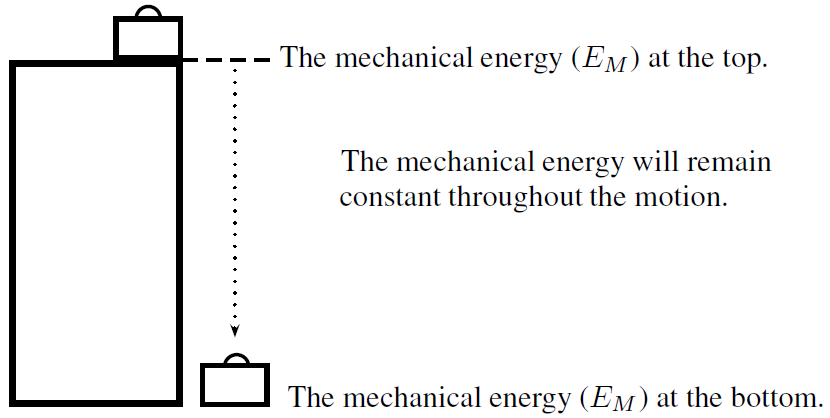| << Chapter < Page | Chapter >> Page > |
We can now use the conservation of mechanical energy to calculate the velocity of a body in freefall and show that the velocity is independent of mass.
Show by using the law of conservation of energy that the velocity of a body in free fall is independent of its mass.
In the presence of friction, mechanical energy is not conserved. The mechanical energy lost is equal to the work done against friction.
In general, mechanical energy is conserved in the absence of external forces. Examples of external forces are: applied forces, frictional forces and air resistance.
In the presence of internal forces like the force due to gravity or the force in a spring, mechanical energy is conserved.
The following simulation covers the law of conservation of energy.
run demo

Mechanical energy is conserved (in the absence of friction). Therefore we can say that the sum of the and the anywhere during the motion must be equal to the sum of the and the anywhere else in the motion.
We can now apply this to the example of the suitcase on the cupboard. Consider the mechanical energy of the suitcase at the top and at the bottom. We can say:

The suitcase will strike the ground with a velocity of .
From this we see that when an object is lifted, like the suitcase in our example, it gains potential energy. As it falls back to the ground, it will lose this potential energy, but gain kinetic energy. We know that energy cannot be created or destroyed, but only changed from one form into another. In our example, the potential energy that the suitcase loses is changed to kinetic energy.
The suitcase will have maximum potential energy at the top of the cupboard and maximum kinetic energy at the bottom of the cupboard. Halfway down it will have half kinetic energy and half potential energy. As it moves down, the potential energy will be converted (changed) into kinetic energy until all the potential energy is gone and only kinetic energy is left. The of potential energy at the top will become of kinetic energy at the bottom.
During a flood a tree truck of mass falls down a waterfall. The waterfall is high. If air resistance is ignored, calculate

The kinetic energy of the tree trunk at the bottom of the waterfall is equal to the potential energy it had at the top of the waterfall. Therefore .
To calculate the velocity of the tree trunk we need to use the equation for kinetic energy.

Notification Switch
Would you like to follow the 'Physics - grade 10 [caps 2011]' conversation and receive update notifications?